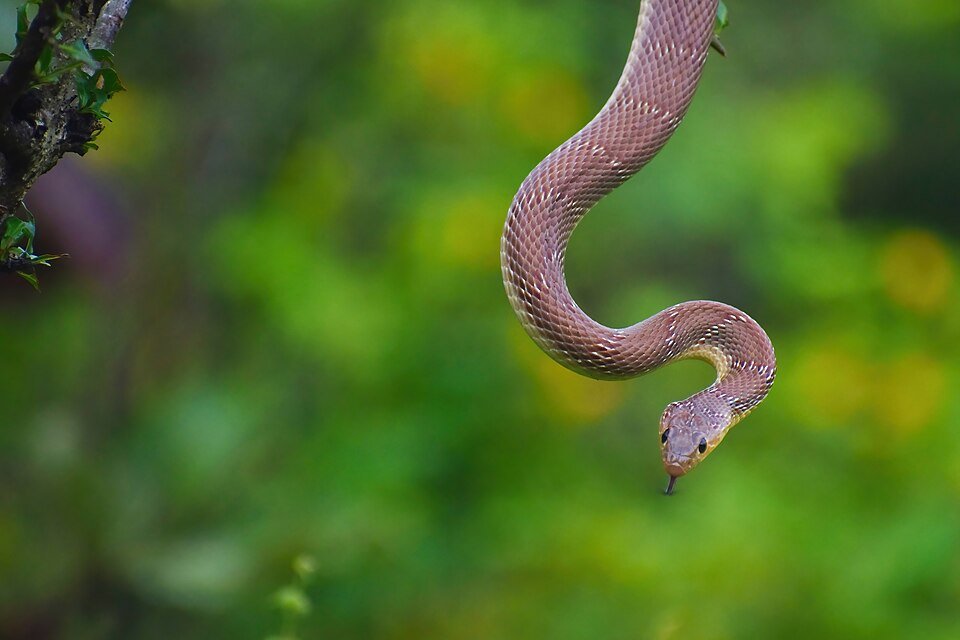The Banded Racer Snake, scientifically known as Argyrogena fasciolata, is a fast-moving and non-venomous snake commonly found across parts of India and South Asia. It is often mistaken for more dangerous species because of its appearance, but in reality, it’s a harmless and beneficial snake that plays a vital role in controlling rodent populations. This snake gets its name from the distinct dark bands along its body, which fade as it grows older. The Banded Racer is active during the day (diurnal) and is most commonly seen in forests, agricultural fields, and grasslands.
These snakes are quick to escape when disturbed and rarely bite unless handled roughly. Unfortunately, due to lack of awareness, they are often killed on sight out of fear. At Wildlife Nest, our aim is to spread awareness about such misunderstood species and highlight their ecological importance. Protecting snakes like the Banded Racer is essential for maintaining a balanced ecosystem, especially in areas where crop damage by rodents is a significant concern.
Banded Racer Snake

Species Profile of Banded Racer Snake
| Field | Information |
|---|---|
| Snake Name | Banded Racer Snake |
| Scientific Name | Argyrogena fasciolata |
| Wild Life Protection Act (India) | Schedule IV (Least Concern) |
| Regional Names | English: Banded Racer Marathi: धूल नागिन (Dhool Nagin) पट्टेरी धूळनागीण (Patteri Dhoolnagin) नायकूळ (Naykool) – (Tal Konkan region) धूरनागीण (Dhoornagin) – (Vidarbha region) गव्हाळ्या (Gavhalya) – (Marathwada region) ताडजेरी (Tadjeri) – (Gadchiroli region) Gujarati: ઘઉંલો (Ghauṃlo) Kannada: ಜೋರುಪೋತ (Joru Potha) Tamil: ஓடுகாலிப்பாம்பு (Odugali pambu) Odia (Oriya): ବୋଇଲ (Boila) |
| Physical Description | Slender body, light brown to olive with dark crossbands; bands fade with age |
| Habitat | Forests, grasslands, urban outskirts, farmlands |
| Diet | Rodents, lizards, frogs, small birds |
| Behaviour | Diurnal, fast-moving, non-aggressive, shy |
| Venomous or Non-Venomous | Non-Venomous |
| Venom Type | None |
| Venom Effects on Prey | Not applicable |
| Venom Effects on Humans | Harmless |
| Common or Rare Species | Common in its distribution range |
| Life Span | 8–12 years (in the wild) |
| Mating & Reproduction | Oviparous; lays eggs during warmer months, 5–15 eggs per clutch |
Introduction to Snakes
Snakes like the Banded Racer belong to the reptilian group and are part of a larger ecosystem that keeps nature balanced. Their general characteristics include elongated bodies without limbs, forked tongues for sensing their environment, and highly flexible jaws that allow them to consume prey larger than their heads. The Banded Racer, in particular, has evolved speed and agility to chase down its prey during the day. Unlike some nocturnal snakes, it relies on keen eyesight and quick reflexes.
In the ecosystem, Banded Racers serve as natural pest controllers. By feeding on rodents and insects, they help prevent crop damage and maintain ecological harmony. Yet, myths surrounding snakes often lead to unnecessary fear. A common misconception is that all snakes are venomous or dangerous to humans. This is far from the truth. In fact, the majority of snakes, including the Banded Racer, are non-venomous and actually avoid human contact.
Understanding the real nature of these reptiles helps dispel fear and encourages conservation. The Banded Racer is a perfect example of how a misunderstood species can be a friend, not a foe. Let’s help spread the truth about such snakes with the right knowledge!
Habitat and Distribution of Banded Racer Snake
The Banded Racer Snake is widely distributed across India, Bangladesh, Nepal, and parts of Pakistan. It prefers warm and dry regions but is highly adaptable and can thrive in various environments. These snakes are commonly found in forests, scrublands, agricultural fields, and even urban areas near human settlements. Their adaptability allows them to hunt in fields where rodents are abundant, making them valuable allies for farmers.
While they prefer staying close to the ground, they are agile enough to climb shrubs or walls when hunting or escaping danger. During the hottest part of the day, they may rest in burrows or under rocks. Being diurnal, they hunt during daylight, which increases the chances of being spotted by people. Despite this, their quick reflexes help them escape most threats.
Sadly, habitat destruction due to urbanization and farming expansion is affecting their numbers in some areas. Preserving green spaces and educating people about their harmless nature is crucial for their protection.
| Habitat Type | Description |
|---|---|
| Forests | Dry deciduous and mixed forests with plenty of undergrowth |
| Grasslands | Open grassy fields with rodents and hiding spots |
| Agricultural Lands | Especially sugarcane, wheat, and paddy fields where rodent activity is high |
| Urban Outskirts | Abandoned buildings, gardens, or stone piles where they seek shelter |
| Wetlands (Occasional) | Edges of wetlands or moist areas with amphibians |
Snake Behaviour
The Banded Racer Snake is known for its swift movements and alert behavior. It is a daytime hunter, using its excellent vision and speed to capture prey. Unlike ambush predators, it actively chases down its prey—typically rodents, small birds, and lizards. This active foraging style is a key characteristic of the species.
In terms of reproduction, Banded Racers are oviparous, meaning they lay eggs. During the breeding season, usually in the summer months, a female may lay 5 to 15 eggs in moist and hidden areas such as under logs or within burrows. The hatchlings are independent from birth and resemble miniature adults.
For defense, Banded Racers rely on speed and camouflage. They can vibrate their tails rapidly in dry leaves to mimic the sound of a rattlesnake, scaring off potential predators. If cornered, they may flatten their bodies and strike—but without venom, their bite is harmless. They rarely show aggression unless provoked or trapped.
This behavior reflects the snake’s non-aggressive nature and preference to flee over fight, making it one of the safer snakes to encounter in the wild.
First Aid and Medical Treatment
Banded Racer Snakes are non-venomous, meaning their bite poses no serious medical threat to humans. However, if a bite occurs due to mishandling:
- Clean the wound with soap and water.
- Apply antiseptic to prevent infection.
- Monitor for signs of allergic reaction (swelling, redness).
- Seek medical help only if symptoms persist or if the identity of the snake is uncertain.
Since there’s no venom involved, anti-venom is not required for Banded Racer bites. Prompt and proper wound cleaning is sufficient. Still, it’s best not to handle wild snakes to avoid unnecessary incidents.
Global Impact of Banded Racer Snake Bites
Globally, the Banded Racer has no major impact when it comes to snakebite incidents. Being a non-venomous species, it is not included in global statistics for fatal or medically significant bites. On the contrary, its presence in ecosystems helps reduce the number of rodents and pests, which can otherwise carry diseases and damage crops.
By reducing pest populations naturally, these snakes indirectly benefit public health and food security. Conservation of such species helps maintain ecological stability and biodiversity on a broader scale.
If You Encounter a Snake on Your Property
Remain Calm and Assess the Situation: Do not panic—most snakes, including the Banded Racer, are harmless and will leave on their own.
Ensure Safety: Keep pets and children away from the area to avoid accidental encounters or bites.
Identify the Snake (If Possible): Try to observe the snake’s color and pattern from a safe distance without attempting to capture it.
Contact Professional Help: Call local wildlife rescue or forest department authorities to handle the situation.
Prevent Future Encounters: Seal cracks in walls, store food securely, and reduce clutter to make your property less inviting to snakes.
Educate Yourself and Others: Learn about local snake species like the Banded Racer to better understand and peacefully coexist with them.
Tips for Snake Enthusiasts
How to Safely Observe Snakes in the Wild:
- Wear boots and long pants while walking in snake habitats.
- Avoid sudden movements and stay on trails.
- Use binoculars or zoom lenses to observe from a distance.
Tips for Aspiring Herpetologists:
- Start by learning to identify local species like the Banded Racer.
- Join wildlife or herpetology groups for field experiences.
- Respect all wildlife—never handle snakes unless trained to do so.
- Document sightings responsibly and contribute to citizen science.
Interesting Facts about Banded Racer Snake
- Master of Disguise: Juvenile Banded Racers have sharp, clear bands, but as they grow, these fade, making older snakes harder to spot in their environment.
- Fast Like a Racer: True to their name, they can slither at high speeds, especially when chasing prey or fleeing from predators.
- Tail Talk: Banded Racers vibrate their tails in dry leaves to mimic the sound of a rattlesnake—a brilliant defense strategy!
- Daylight Hunter: Unlike most snakes, this one prefers daytime hunting, using sharp eyesight to catch quick-moving prey.
- Egg-layer Extraordinaire: A single female can lay up to 15 eggs, ensuring good survival rates despite predators.
- Completely Harmless: Though often feared, the Banded Racer is 100% non-venomous and safe to have around farmlands.
- Rodent Terminator: These snakes are highly effective in controlling rodent populations, often doing a better job than traps or poison.
- Farmer’s Friend: Many farmers who recognize this snake’s value allow it to live undisturbed in their fields.
- Highly Adaptable: From forests to city outskirts, the Banded Racer can live almost anywhere, showcasing its survival skill.
- Rarely Seen in Captivity: Because of their shy nature and high activity levels, they are not commonly kept even by herpetologists.
Frequently Asked Questions (FAQs) about Banded Racer Snake
1. Is the Banded Racer Snake venomous?
No, the Banded Racer Snake is completely non-venomous. It does not pose any threat to humans and is generally very shy. Even if it bites in self-defense, it causes no harm except minor scratches.
2. Where is the Banded Racer Snake found in India?
The Banded Racer is commonly found across various parts of India, especially in forests, grasslands, agricultural fields, and near villages. It adapts well to human environments, making it fairly common in many regions.
3. What does the Banded Racer Snake eat?
This snake loves to feast on rodents, lizards, frogs, and sometimes small birds. It helps keep the population of pests under control, especially in farmlands.
4. Is it safe to have a Banded Racer Snake in my garden or farmland?
Yes, absolutely! The Banded Racer is harmless and actually beneficial. It keeps rodent populations down and plays an important role in maintaining ecological balance.
5. What should I do if I see a Banded Racer Snake?
Stay calm and don’t panic. Observe from a distance and do not try to catch or kill it. The snake will likely move away on its own. If needed, contact a local wildlife rescuer.
6. How can I identify a Banded Racer Snake?
Juvenile Banded Racers have distinct dark bands across their bodies, which fade with age. They have a slender, smooth body and are generally olive or light brown in color. They’re fast movers and active during the day.
7. Can a Banded Racer Snake climb walls or trees?
Yes! While it’s mostly ground-dwelling, the Banded Racer is quite agile and can climb shrubs, low walls, or branches, especially while chasing prey or escaping predators.
8. How does the Banded Racer reproduce?
The Banded Racer is oviparous, which means it lays eggs. A female can lay 5 to 15 eggs in hidden, moist places like burrows, and the young snakes hatch fully independent.
9. Does the Banded Racer Snake attack humans?
No, this snake is non-aggressive and prefers to flee rather than fight. It may flatten its body or pretend to strike when threatened, but it does not attack unless provoked.
10. Why is the Banded Racer Snake important to the ecosystem?
Banded Racers help control rodent and pest populations, making them farmers’ best friends. They also serve as prey to larger animals, playing a key role in the food chain.
Watch Wildlife Awareness Videos
For more engaging and educational content on snakes and other wild creatures, don’t forget to visit our official YouTube channel: www.youtube.com/@WildlifeNest
Subscribe and explore fascinating wildlife stories, awareness videos, and rare sightings—all brought to you by Wildlife Nest!
Related Snake Species – Explore More on Wildlife Nest
| Snake Species / Topic | Read Article |
|---|---|
| Indian Rat Snake | Read Article |
| Common Sand Boa Snake | Read Article |
| Indian Rock Python | Read Article |
| Two Step Snake | Read Article |
| King Cobra Secrets – Study Breaks 180 Year Myth | Read Article |
| Slender Coral Snake | Read Article |
| The Green Vine Snake – An In-Depth Look | Read Article |
| Common Cat Snake – All Information | Read Article |
| Banded Krait Snake – All Information | Read Article |
| King Cobra – All Information | Read Article |
| Common Krait – All Information | Read Article |
| Russell’s Viper | Read Article |
| Saw Scaled Viper Snake – All Information | Read Article |
| Cobra Snake – All Information | Read Article |
| The Big Four Snakes of India | Read Article |
| What Are Reptiles? | Read Article |
| The Deadliest Venom | Read Article |
| Most Dangerous Snakes in the World | Read Article |
| The Ultimate Guide to Snakes | Read Article |
| History of Snakes – Evolution, Habitats, Survival | Read Article |



